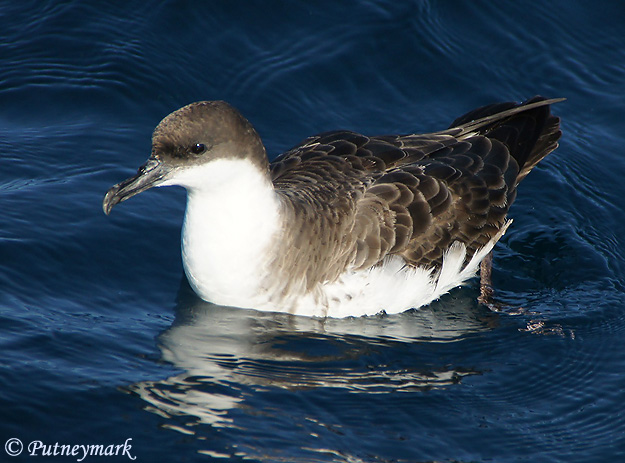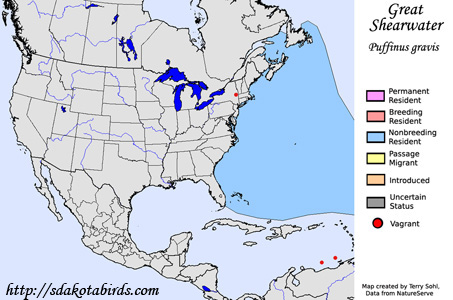| Length: 18 inches | Wingspan: 42 inches | Seasonality: Non-resident in South Dakota |
| ID Keys: Large for Atlantic Shearwater, dark upperparts, dark cap, thin black bill, white neck, breast, and underparts | ||
 The
Great Shearwater is one of the largest shearwaters found in the North
Atlantic, where they are common during the summer months. Great
Shearwaters are very long distance migrants, as they breed on a few islands
in the South Atlantic, and then move to the North Atlantic during the
Northern Hemisphere summer. They are a common sight around fishing
boats in the North Atlantic, where they will follow boats to feed on
discarded scraps and other waste.
The
Great Shearwater is one of the largest shearwaters found in the North
Atlantic, where they are common during the summer months. Great
Shearwaters are very long distance migrants, as they breed on a few islands
in the South Atlantic, and then move to the North Atlantic during the
Northern Hemisphere summer. They are a common sight around fishing
boats in the North Atlantic, where they will follow boats to feed on
discarded scraps and other waste.
Habitat: Nests on islands in the south Atlantic with soil soft enough to build burrows. Outside of the breeding season, they are found in colder offshore waters, typically not approaching the shoreline.
Diet: Feeds mostly on small fish and squid. Will also eat crustaceans and other small marine life, and will follow fishing boats to feed on fishing waste.
Behavior: May use a variety of foraging techniques, including plunge diving, swimming and plucking items from near the ocean's surface, or by swimming and diving underwater in pursuit of prey. Will feed at any time during the day or night, but most often forages during daylight hours.
Nesting: The Great Shearwater mostly nests in burrows in the ground, although they will also sometimes use crevices and gaps in rocky areas. The female lays a single egg, and both the male and female help to incubate it. After hatching, both parents help feed the nestling.
Song: Generally silent except when feeding, when groups of Great Shearwaters can be heard making a whinnying sound.
Migration: Long-distance migrant, breeding on select islands in the South Atlantic, and moving northward and spending the Northern Hemisphere summer in the North Atlantic.
Interactive eBird Map: Click here to access an interactive eBird map of Great Shearwater sightings
Similar Species: Most similar in overall appearance to Cory's Shearwater. They can be readily differentiated by their bill, with the Cory's Shearwater having a thicker yellow bill, and the Greater Shearwater having a thin black bill. Plumage and overall shape are also distinct if seen well.
Conservation Status: Populations appear to be stable, and Great Shearwaters are common in many areas. The IUCN lists the Great Shearwater as a species of "Least Concern".
Further Information: 1) BirdLife International - Great Shearwater
2) Whatbird - Great Shearwater
3) New Zealand Birds Online - Great Shearwater
Photo Information: Photo taken by "Putneymark" - Photo licensed under Creative Commons Attribution ShareAlike 2.0 Generic license.
| Click below for a higher-resolution map |
 |
| South Dakota Status: Non-resident in South Dakota |
Additional Great Shearwater Photos (coming soon!!)
